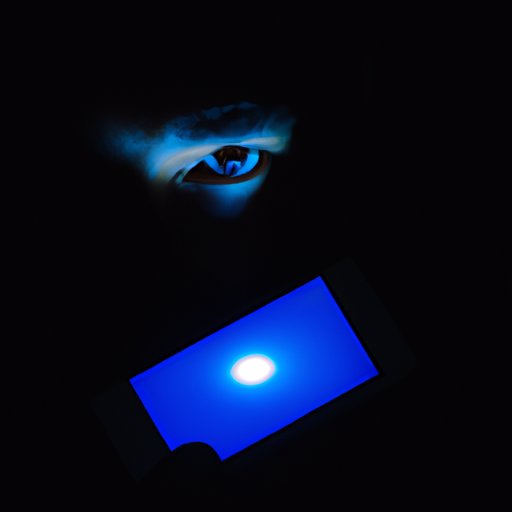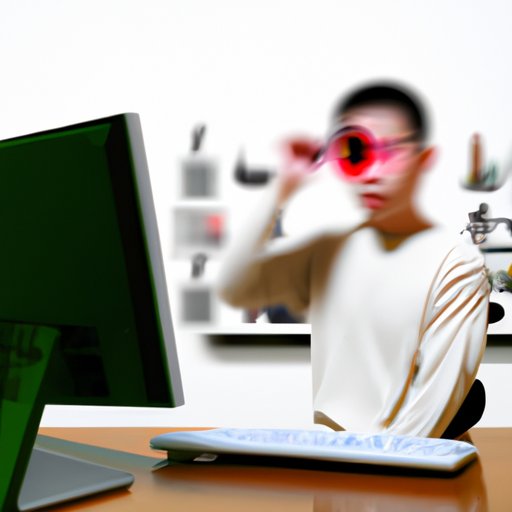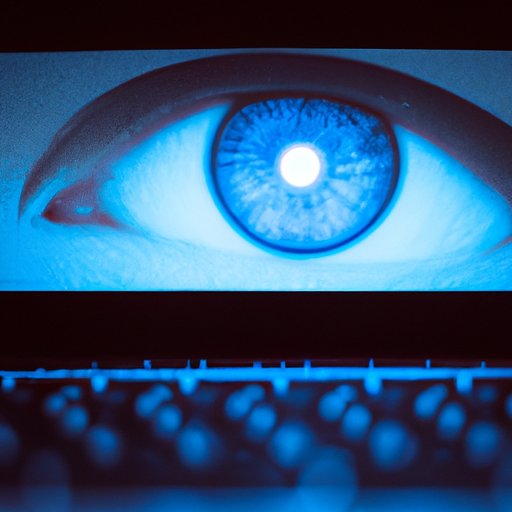Introduction
Technology is becoming increasingly ubiquitous in our lives, from smartphones to smart TVs and tablets. In many ways, technology has improved our lives, providing us with access to information, entertainment, and communication. But along with its many benefits, there are potential downsides to consider when it comes to technology and its effect on our health, including our eyes.
Our eyes are particularly vulnerable to the effects of technology because of the way we interact with devices. We often spend long hours looking at screens, exposing our eyes to bright light, glare, and other factors that can cause damage. As technology becomes more advanced, it’s important to be aware of the potential risks and take steps to protect our eyes.

How Blue Light from Digital Devices Can Damage Your Eyes
Blue light is a type of light that is emitted by electronic devices such as computers, tablets, and smartphones. According to the American Macular Degeneration Foundation, “exposure to blue light over time may increase the risk of macular degeneration, a medical condition that can lead to vision loss.” Studies have also found that blue light exposure can lead to digital eyestrain, which can cause headaches, fatigue, and blurred vision.
The best way to minimize blue light exposure is to reduce the amount of time spent looking at digital screens. Turn off all devices at least two hours before bedtime, and use blue-light-blocking glasses if you must use devices during the evening hours. It’s also a good idea to take regular breaks from looking at screens throughout the day.
How Too Much Screen Time Can Lead to Eye Strain and Fatigue
Staring at a screen for extended periods of time can cause eye strain and fatigue. This is because our eyes are not designed to focus on one thing for long periods of time, and the bright light from the screen can make our eyes work harder than normal. Common symptoms of digital eye strain include headaches, dry eyes, blurry vision, and neck and shoulder pain.
To reduce digital eye strain, try the 20-20-20 rule: every 20 minutes, look away from the screen for 20 seconds at something 20 feet away. It’s also important to make sure that your screen is at the correct height and distance from your eyes so that you don’t have to strain to see it. Finally, adjust the brightness and contrast settings on your device to reduce glare.

The Risk of Developing Computer Vision Syndrome from Excessive Technology Use
Computer vision syndrome (CVS) is a condition that can occur after prolonged use of digital devices. Symptoms of CVS include headaches, dry eyes, blurred vision, and neck and shoulder pain. The best way to prevent CVS is to take regular breaks from looking at screens and to make sure that your screen is at the correct height and distance from your eyes.
If you experience symptoms of CVS, it’s important to see an optometrist or ophthalmologist to get a proper diagnosis. Treatment options may include using special lenses or glasses with anti-reflective coating, taking frequent breaks from looking at screens, and making sure that your screen is at the correct height and distance from your eyes.
The Impact of Technology on Sleep Quality and Eye Health
Using technology late at night can have a negative impact on your sleep quality and overall eye health. Exposure to blue light from devices can disrupt the production of melatonin, which is a hormone that helps regulate our sleep cycles. Without enough melatonin, it can be difficult to fall asleep and stay asleep.
To improve sleep quality, turn off all devices at least two hours before bedtime and avoid using them in the bedroom. If you must use a device at night, use blue-light-blocking glasses or install a blue light filter on your device. Taking a warm bath or shower before bed and exercising regularly can also help improve sleep quality.

The Dangers of Prolonged Exposure to UV Rays from Screens
Prolonged exposure to ultraviolet (UV) rays from digital screens can increase the risk of developing certain eye conditions, such as cataracts, macular degeneration, and photokeratitis. To reduce your risk of these conditions, make sure to wear sunglasses when outside and limit your exposure to direct sunlight. You should also avoid looking directly at the sun, even if you are wearing sunglasses.
When using digital devices indoors, it’s important to remember that some screens emit UV rays. To reduce your risk of eye damage from UV rays, keep your devices at least 12 inches away from your face and use a screen protector to block out any potentially harmful rays.
Conclusion
Technology can be beneficial in many ways, but it’s important to be aware of the potential risks associated with excessive technology use. Prolonged exposure to blue light, digital eye strain, and UV rays from screens can all lead to serious eye problems. To minimize these risks, take regular breaks from looking at screens, use blue-light-blocking glasses, and wear sunglasses when outdoors.
By following these simple tips, you can help protect your eyes and enjoy the many benefits of technology without sacrificing your eye health.
(Note: Is this article not meeting your expectations? Do you have knowledge or insights to share? Unlock new opportunities and expand your reach by joining our authors team. Click Registration to join us and share your expertise with our readers.)
